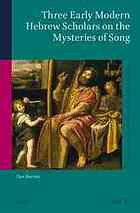
Three early modern Hebrew scholars on the mysteries of song PDF
Preview Three early modern Hebrew scholars on the mysteries of song
ThreeEarlyModernHebrewScholarsontheMysteriesofSong Studies in Jewish History and Culture Editedby GiuseppeVeltri EditorialBoard GadFreudenthal–AlessandroGuetta–HannaLiss RonitMeroz–ReimundLeicht–JudithOlszowy-Schlanger DavidRuderman–DianaMatut volume 47 Thetitlespublishedinthisseriesarelistedatbrill.com/sjhc Three Early Modern Hebrew Scholars on the Mysteries of Song By DonHarrán leiden | boston Coverillustration:DomenicoZampieri(1581–1641),KingDavidPlayingaHarp(1619).240×170cm (94.49×66.93inches).Oiloncanvas.Versailles,MuséeNationaldesChâteauxdeVersaillesetdeTrianon (MV5359).Copyright,Versailles,MuséeNationaldesChâteauxdeVersaillesetdeTrianon. LibraryofCongressCataloging-in-PublicationData Harran,Don,author. ThreeearlymodernHebrewscholarsonthemysteriesofsong/byDonHarrán. pagescm.–(StudiesinJewishhistoryandculture;volume47) Includesbibliographicalreferencesandindexes. ISBN978-90-04-28302-2(hardback:alk.paper)–ISBN978-90-04-28364-0(e-book)1.Moscato,Judahben Joseph,approximately1530-approximately1593.2.Modena,Leone,1571-1648.3.Portaleone,Abrahamben David,1542-1612.4.Jews–Music–Historyandcriticism.I.Title. ML3195.H232014 780.89'924–dc23 2014032288 Thispublicationhasbeentypesetinthemultilingual“Brill”typeface.Withover5,100characterscovering Latin,ipa,Greek,andCyrillic,thistypefaceisespeciallysuitableforuseinthehumanities.Formore information,pleaseseewww.brill.com/brill-typeface. issn1568-5004 isbn978-90-04-28302-2(hardback) isbn978-90-04-28364-0(e-book) Copyright2015byKoninklijkeBrillnv,Leiden,TheNetherlands. KoninklijkeBrillnvincorporatestheimprintsBrill,BrillNijhoffandHoteiPublishing. Allrightsreserved.Nopartofthispublicationmaybereproduced,translated,storedinaretrievalsystem, ortransmittedinanyformorbyanymeans,electronic,mechanical,photocopying,recordingorotherwise, withoutpriorwrittenpermissionfromthepublisher. AuthorizationtophotocopyitemsforinternalorpersonaluseisgrantedbyKoninklijkeBrillnvprovided thattheappropriatefeesarepaiddirectlytoTheCopyrightClearanceCenter,222RosewoodDrive, Suite910,Danvers,ma01923,usa.Feesaresubjecttochange. Thisbookisprintedonacid-freepaper. Contents ListofIllustrations vii Acknowledgments viii Introduction:MusicinHebrewWritingsfromtheBibletotheEarly SeventeenthCentury 1 judahmoscato Spirituality 1 JudahMoscatoontheSpiritualityofMusic 29 2 SoundsforContemplationonaLyre 47 leonmodena Legality 3 LeonModenaontheLegalityofArtMusicintheSynagogue 131 4 IsArtMusicPermissibleintheSynagogue? 151 abrahamportaleone Praxis 5 AbrahamPortaleoneonthePracticeofMusicintheAncient Temple 177 6 MusicasPracticedintheTempleandtheEarlyModernEra 206 Epilogue:TheJewishContributiontoMusicTheoryintheEarlyModern Era 254 vi contents Appendix:TheTextsinHebrew 263 1. Moscato:SermonOne 263 2. Modena:Response 291 3. Portaleone:SelectedChapters 298 Bibliography 314 AbbreviationsandAcronymsinHebrew 340 LexiconofHebrewMusicalTerms 346 IndexofSources 373 GeneralIndex 383 List of Illustrations 1 AthanasiusKircher’sdepictionofthemaḥolasastringinstrumentin Musurgiauniversalis,1:48–49(1650) 11 2 OpeningofJudahMoscato’ssermon“Higgayonbe-khinnor”(Soundsfor contemplationonalyre)inSefernefutzotYehudah[BookoftheDispersed ofJudah],1a(1589) 32 3 OpeningofLeonModena’sresponseonmusicinLondon,BritishLibrary, msAdd.27148,9a(1605) 139 4 OpeningofLeonModena’sresponseonmusicasprintedinSalamone Rossi’sHa-shirimasherli-Shelomoh[TheSongsbySolomon],[4]b (1623) 148 5 OpeningofAbrahamPortaleone’schapter4,inSefershilteiha-gibborim [BookoftheShieldsofHeroes],onartmusicintheTemple,3a (1612) 186 6 Women’scourtinancientTemplewithcurvedstaircaseoffifteensteps leadinguptotheNicanorGate(afterMichaelAviYonah’sreconstruction oftheTempleinamodelintheHolylandHotel,Jerusalem).Acrossfrom thecourtwerechamberswhereinstrumentswerekeptfortheuseofthe Levites(Mishnah,Middot,2:6) 195 7 DavidasharpistinapaintingbyDomenicoZampieri(1619) 197 8 DavidasharpistinaJewishsource:SeferhaggadahshelPesaḥ [CeremonialoftheHaggadahforPassover],4a(1609) 202 9 Reconstructionofkinnor(harp)asdescribedbyPortaleoneinchapter9 ofSefershilteiha-gibborim[BookoftheShieldsofHeroes],8a–b (1612) 246 Acknowledgments IwishtothankBrillforpermissiontouseJudahMoscato’ssermon(chapter2), originallypublishedinvolume1ofMoscato,SefernefutzotYehudah[Bookof the Dispersed of Judah], Hebrewtext (Venice1589), in an annotated English translationin JudahMoscato,Sermons:VolumeOne,editedbyGiuseppeVeltri andGianfrancoMilettoinconjunctionwithGiacomoCorazzol,ReginaGrund- mann,DonHarrán(Sermon1),YonatanMeroz,BrianOgren,andAdamShear (Leiden,Boston,ma:Brill,2011),63–123(English),הכ–אי[11–25](Hebrew).Ialso wishtothanktheAmericanInstituteofMusicologyforpermissiontouseLeon Modena’s response (chapter 4), originally published in my edition of Salam- oneRossi’sHa-shirimasherli-Shelomoh[TheSongsbySolomon]involume13a of Rossi’s CompleteWorks (Middleton, wi: American Institute of Musicology, 2003),193–211.Inbothcases,thematerialhasbeenrethoughtandcompletely revised. An important work, though one that treats Hebrew music theory in an entirely different way, is the recent book to be mentioned by Dov Schwartz, Kinornishmati.TouchingonthethreeauthorsMoscato,Modena,andPortale- oneonlymarginally,itattemptsrathertolocatewiderstreamsofthoughtin Jewish practice.One significant explanation of a major passagein Moscato’s sermonwillbehighlightedinchapter1. I could not have written this book without my wife, who understood and encouraged.NorcouldIhavewrittenitwithouttheresearchofmycolleagues innumerousareasofinquiry.Jewishstudiesappeartobethrivingtoday.Were thisstudyof“ThreeEarlyModernHebrewScholarsontheMysteriesofSong”to addinsomewaynotonlytothe“mysteries”ofsongbutalsotoJewishmusical thoughtinitsintricateramificationsforallfieldsoflearning,itsgoalwillhave beenachieved. introduction Music in Hebrew Writings from the Bible to the Early Seventeenth Century At the center of this study are three major writings on Hebrew music the- ory from the early modern era: a sermon by Judah Moscato, a question to whichLeonModenarepliedinaresponse,andselectedportionsfromatrea- tise by Abraham Portaleone. In length and significance they form the high pointinaspecificallyHebrewtraditionofmusicalthought.Thetraditiondevel- opedalongsideancientGreekandmedievalIslamicandEuropeanwritingson music,andoftendrewfromtheirsubjectsinacomplexpatternofculturaland conceptual interchanges. Yet it differs from them in having its own intrinsi- callyHebrewsourcestraceableintheirthemesandcontentstotheBible,the Mishnah,theTalmud,andlaterrabbinicalwritings,someofthemlegalintheir approach,othershomiletic,philosophical,andkabbalistic.Thepurposeofthis introductionistodescribethesourcesasthehistoricalbackdropforthethree writings. AnytreatmentofearlyHebrewmusictheoryinevitablyrestsontheachieve- mentsofnotedscholars,amongthemEricWerner,HanochAvenary,Amnon Shiloah,andIsraelAdler,thelastofwhom,inanannotatedHebrewtranscrip- tion,presentedawidecorpusofHebrewwritingsonmusicfromtheearlytenth toearlyseventeenthcenturies.1Theliteraturebytheseandotherauthorities includesstudiesthatsummarizethebibliographyofJudeo-Arabicwritingson music2andthatdealwithindividualworks,3someofthemadditionstothose 1 HebrewWritingsConcerningMusicinManuscriptsandPrintedBooksfromGeonicTimesupto 1800,ed.IsraelAdler.Fortheothers’works,seethefootnotesbelowandtheBibliographyat theendofthisvolume. 2 Forthosedealingwithbibliography,seeEricWernerandIsraelSonne,“ThePhilosophyand TheoryofMusicinJudeo-ArabicLiterature”;HanochLoewenstein(laterAvenary),“Ḥokhmat ha-musikahbi-mekorotyehudiyyimme-ha-meʾahha-yodve-ʿadha-meʾahha-yodzayin”[The ScienceofMusicinJewishSourcesfromtheTenthuntiltheSeventeenthCenturies];Hanoch Avenary,“Ḥokhmatha-musikahbi-mekorotyehudiyyimbi-yemeiha-beinayimu-vi-tekufat ha-teḥiyyah”[TheScienceofMusicinJewishSourcesintheMiddleAgesandthePeriodof theRenaissance](arevisedversionofthepreviousitem). 3 E.g.,IsraelAdler,“Fragmenthébraïqued’untraitéattribuéàMarchettodePadoue”;Ave- nary, “The Hebrew Version of Abū l-Salt’s Treatise on Music”; Miriam Ben-David Sheer, © koninklijkebrillnv,leiden,2015 | doi:10.1163/9789004283640_002 2 introduction inAdler’svolume.4Allinall,thenumberofprimarysourcesislimited—maybe sixtytoseventy.Nolesslimitedistheircoverage:sometimesmusicisaddressed inasingleparagraph,othertimesinasinglechapterorinscatteredreferences inoneormorechapters.Onlyrarelydoesonefinditasconsistentlyandcal- culatedlytreatedasinthethreewritingsbyMoscato,Modena,andPortaleone, hencetheirprominenceintheliterature. For Avenary, Hebrew writings on music divide into three periods: those frombeforethefourteenthcentury,ofIslamicorigin,and“assimilatedbythe Jewishpublicintheiroriginalform,thoughwritteninHebrewletters,”orthe sameinHebrewtranslations,orindependenttractatesbyJewsinbothHebrew and Arabic; the “Ars Nova” and its continuation into the early Renaissance (fourteenth and fifteenth centuries); and the Renaissance proper (sixteenth andseventeenthcenturies).5 Morefundamentally,theperiodizationforcesthequestion:howdoesone define a Hebrew writing on music? The coverage is broader than one might expect. Not only does it include all works on music written in Hebrew, but itdoesothersoriginallywritteninArabic,yettranscribed,asnotedabove,in Hebrewletters;forexample,thefew,thoughsignificantreferencestomusicin Seferha-Kuzari[BookoftheKhazar]byJudahHalevi(d.1141).6Totheseone might add works on music by Jews, Moslems, or Christians in Arabic, Latin, orItalian,yettranslatedintoHebrew—forexample,theHebrewtranslation, by Judah ben Saul ibn Tibbon (d. after 1190), of the same writing, in Arabic, byJudahHalevi;orananonymousLatintreatiseonmusicaplana(plainchant) translatedintoHebrewbyJudahbenIsaac(fourteenthorfifteenthcentury); or a treatise on musicaplana thought to have been written by Marchetto da Padua(fl.1305–1319)andtranslatedbyanunknownscribefromLatinorItalian intoHebrew—allthatremainsofitisitsinitialpart.7Theunifyingelementin “Delmedigo’sSeferElimasaHebrewSourceonMusicTheory”;H.G.Farmer,Maimonideson ListeningtoMusic;idem,SaadyahGaonontheInfluenceofMusic;AmnonShiloah,“‘EnKol’— CommentairehébraïquedeShemTovibnShaprutsurleCanond’Avicenne”;idem,“The MusicalPassageinIbnEzra’sBookoftheGarden”;andJosephSmitsvanWaesberghe,“The TreatiseonMusicTranslatedintoHebrewbyJudabenIsaac(ParisB.N.Héb.1037,22v–27v).” 4 E.g.,Shiloah,“APassagebyImmanuelha-RomiontheScienceofMusic”;andAdler,“Liku- timbe-ḥokhmatha-musikahbi-khetavyadLondon,ha-sifriyyahha-beritit,Or.10878”[Col- lectaneaConcerningMusicintheHebrewManuscriptLondon,BritishLibrary,Or.10878]. 5 Avenary,“Ḥokhmatha-musikah,”158. 6 JudahHalevi,Seferha-Kuzari(1506),[21]b–[23]a. 7 See,forthethree,HebrewWritingsConcerningMusic,ed.Adler,respectively198–201,81–88, and207–208.
